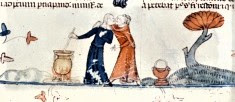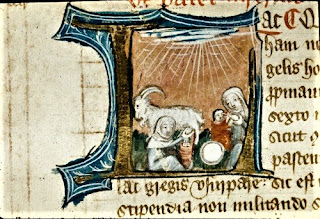So much of the fascination of history is accounts of kings and queens, mighty battles and events that helped shape the modern world. Medieval history is no exception. The murder of Thomas Becket, The Wars of the Roses, Magna Carta, Richard the Lionheart, the Crusades: all indeed showstoppers. But what of the everyday day life that millions of people had to lead? I confess to finding that equally, and at times, even more absorbing. When visiting re-enactments or museums, I’m less taken with sword A or helmet B, but more likely to watch as a woman makes a dish of pottage using twelfth century implements and ingredients.
 |
| Honey, I'm home! |
The fascination for me is that it’s so relatable. Everyone has to make their way in the world and we (most of us, anyway) don’t do it from the battlements of a castle. Yet even in the history of the ordinary man, it tends to be just that. Men. Whatever sparse records exist tend to disappear almost entirely when it comes to women, as so many records are linked to land. We do know some of what life was like for a woman who was not at the top of the social tree: challenging is a word that springs to mind.
 |
| As jobs for women go... |
Everyday women were excluded from holding any kind of office. A woman’s legal rights were defined primarily by men throughout her life. Men defined her description. When she was a maiden, her father was in charge. As a wife, her husband. A medieval legal definition of married women from 1180 tells us that
“every married woman is a sort of infant.” A wife has to agree to her husband’s sexual demands, cannot borrow money without his permission and is not able to make a will. A widow’s standing is based on her late husband’s status. This might suggest some level of independence.
 |
| A woman and a man marry, with a monk performing the marriage. |
But the widow of a villein (a tenant entirely subject to a lord) had, in reality, to remarry. She had a brief few months to make her own choice. If she did not, then the lord’s bailiff or reeve would select her next spouse for her. Refusal brought a fine, or imprisonment. Giving birth to an illegitimate child carried a fine called childwyte. This seems particularly punitive when one considers the law on rape. It was believed that conception could only occur when a woman experienced orgasm. And if she did so, then she had enjoyed the encounter with the man. And so it wasn’t rape. Blinding logic. For medieval men, that is.
 |
| A wild man seizing a woman. |
Childbirth was a terribly risky endeavour for medieval women, no matter what their status in society. It is estimated that for every pregnancy, a woman had a one in fifty chance of dying in childbirth. Women from the lower classes were often employed as wet-nurses for the wealthy.
 |
| A woman nursing her baby as another milks a goat. |
The wives of peasants and villeins shared much of the agricultural labour with their husbands. They could earn money as labourers but were paid about half than men for the same work. Seasonal work paid better than service. Women’s tasks included sheep shearing, milking cows and looking after livestock and chickens, planting, winnowing and weeding. This was on top of all the domestic tasks: keeping a fire, cooking, washing.
 |
| A woman milking a cow. |
The dark hours were put to good use also. Cheese making and brewing could yield a woman some extra income. Many women brewed ale. The demand for ale was high as drinking water was frequently dirty and unsafe. While the brewers were women, the tasters were male and women could be fined for sour beer. With the introduction of hops to brewing (which makes beer, rather than ale and preserves the drink for a lot longer), it became a male-dominated practice, through women continued to sell it.
 |
| A woman fishing with a net. |
With the expansion of towns and cities in the medieval period, women found other opportunities to earn an income. Many unmarried young women opted for service as it gave a yearly wage and moved from the countryside to secure a place. Women also worked as huxters. They would buy produce such as bread, eggs, vegetables or other foods and sell from baskets, either door-to-door or on foot in the increasingly busy marketplaces. The female ale sellers went by some rather wonderful names: gannockers, tapsters or tranters. The money earned in these ways was pitifully small.
 |
| A woman offering a man a loaf of bread. |
Medieval towns also saw the rise of the apprentice, where a young person could be trained to learn a craft over many years. But there were no female guilds, and female apprenticeships do not occur in large numbers in the records. The skilled weavers, for instance, were men.
 |
| A woman carding wool. |
The preparatory work for weaving, such as combing, carding and spinning of the wool tended to be done by women who would be paid little for this work. Silk weaving developed as an all-female craft in London, yet the silk-women only formed a collective, not a guild.
 |
| A woman spinning. |
Laundry was an all-female preserve. Women did their own washing at home, often using unpleasant substances such as lye and urine as cleaning agents. They also worked as laundresses, travelling to the houses of the rich to carry out their duties. Naturally, the work in the laundry is dismissed by some chroniclers as a hot-bed of gossiping. It must in reality have been back-breaking.
 |
| A woman beating a man with a stick- a field day for the gossips! |
Moving to towns and cities made women vulnerable to exploitation. Prostitution was rife. Female prostitutes were tolerated in fourteenth century London so long as they wore a yellow hood that marked them out. This was to save confusion on behalf of men who might mistake a respectable woman for a prostitute.
I like chain-mailed heroes as much as the next medieval history fan. But for me, these forgotten women were pretty darned heroic too.
 |
| A fearless woman taking on a wild boar. |
Speaking as an everyday woman, I'm so privileged I have my life--and not theirs.
~~~~~~~~~~~~~
References:
All images are in the Public Domain and are part of the British Library's
Catalogue of Illuminated Manuscripts.
Dyer, Christopher: Making a Living in the Middle Ages, Yale University Press (2002)
Gies, Frances & Joseph, Life in a Medieval City, New York, Harper & Row (1981)
Gies, Frances & Joseph, Life in a Medieval Village, New York, Harper Perennial (1991)
Leyser, Henrietta, Medieval Women: a Social History of Women in England 450-1500, London, Orion Books Ltd. (1996)
Mortimer, Ian. The Time Traveller's Guide to Medieval England. London: The Bodley Head. (2008)
Whittock, Martyn, A Brief History of Life in the Middle Ages: London, Constable & Robinson (2009)
Note: I originally posted this article or an edited version of it on the English Historical Fiction Authors blog on April 17th 2015.













No comments:
Post a Comment